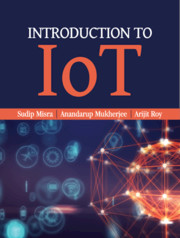15 - Paradigms, Challenges, and the Future
Published online by Cambridge University Press: 09 January 2021
Summary
Learning Outcomes
After reading this chapter, the reader will be able to:
Assess the various evolving aspects and paradigms of IoT
Understand the most prominent challenges encountered during the design and development of IoT solutions
Research upcoming and emerging domains, which find significant applicability in IoT
Introduction
Since the inception of IoT, the technology has passed through multiple stages of development and revolutionized the industrial as well as consumer sectors rapidly. However, developers face multiple challenges while developing their ideas into reality. The IoT devices are usually resource-constrained in terms of their computational capability, battery power, as well as, storage. These limitations mandate the developers to develop routines that execute complex operations on the devices with ease, making IoT applications dependent on external platforms such as cloud and fog computing. Another significant issue is the rising number of IoT devices. IoT has penetrated diverse domains and extends its scope to smart homes, vehicles, cities, utility meters, and others. Such an increase in the number of interacting devices increases the consumption of resources and causes congestion in the network. In addition to that, the devices, along with their interconnections, have a non-trivial topology, which leads to complex networks. The IoT industries, therefore, need to develop new algorithms to deal with the increasing lattices in the complex network as well as multiple access protocols to avoid delays and packet drops. The increasing number of devices also consumes a lot of power, which calls for the development of new low-power hardware and schemes that involve smart energy harvesting and its consumption.
IoT devices include both static as well as mobile nodes, depending on the user's applications. Although mobility in such environments may or may not be random, developers need to be prepared for any pattern while providing their services. Since the precise prediction of mobility is challenging, it can only be analyzed statistically. Additionally, IoT environments also have multiple access points in close proximity. Such a deployment of access points creates interference, causing a reduction in signalto- noise-plus-interference ratio (SINR) values, which causes a decline in signal quality and packet drops. IoT service providers need to impose smart channel selection as well as schemes to overcome these interferences. Developers also need to create new models to mimic the mobility of the users and propose schemes to facilitate smooth handoffs among the access points for uninterrupted service.
- Type
- Chapter
- Information
- Introduction to IoT , pp. 306 - 318Publisher: Cambridge University PressPrint publication year: 2021

